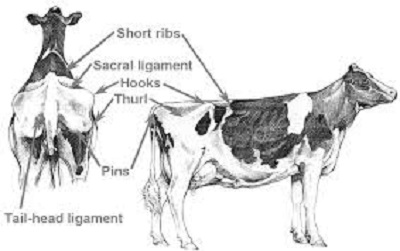Body condition scoring is a method of evaluating fatness or thinness in cows according to a five-point scale (also done on an eight-point scale in some countries) and using the score to fine-tune dairy herd nutrition and health.

On a five-point scale, a score of 1 denotes a very thin cow, while 5 denotes an excessively fat cow. These are extreme scores and should be avoided. The average, 3, is the most desirable for most of the herd. A score with a plus or minus indicates a borderline body condition. For accurate scoring, both visual and tactile appraisals are necessary. The diagram within this article illustrates the dairy cow’s major bone and muscle groups and shows the areas of concern in scoring. Research and field experiments have shown that body condition influences productivity, reproduction, health, and longevity. Thinness or fatness can be a clue to underlying nutritional deficiencies, health problems, or improper herd management. If done on a regular basis, body condition scoring can be used to troubleshoot problems and improve the health and productivity of the dairy herd.
Over-conditioning, or fatness, may result from poor nutrition or reproduction management. A fat cow is more susceptible to metabolic problems and infections and is more likely to have difficulty at calving. Over-conditioning usually begins during the last three to four months of lactation, when milk production has decreased, but grain and total nutrient levels have not been reduced accordingly. Other causes of over-conditioning are prolonged dry periods or overfeeding during dry periods. Under-conditioning, or thinness, can frequently lower production and milkfat levels because of insufficient energy and protein reserves. Thin cows often do not show heat or conceive until they start to regain–or at least maintain–body weight.
When feeding these animals, care must be taken to maintain production while increasing body reserves. Body condition scoring is also useful in dairy heifer feeding management. Thin heifers may not grow rapidly enough to reach puberty by 13 to 15 months of age. They may also be too small to calve at 23 to 25 months or to carry enough weight to maintain a normal first lactation. On the other hand, fat heifers have been shown to produce less milk when they enter the milking herd, especially if they have been fat at puberty. Research demonstrates the relationship of body condition to health, reproduction, feed intake, and milk production.
Related Articles & Free Email Newsletter Sign Up
How Vitamins and Minerals Affect Dairy Cow Health & Fertility
Procedures for Handling Dairy Cows Before They Enter the Food Chain
Why Increased Holstein Milk Production Has Decreased Fertility Rates


Comment here